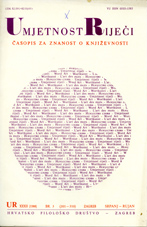Književne vrste u svjetlu engleskih renesansnih poetika
Literary Genres in the Light of English Renaissance Critical Texts
Author(s): Goran StanivukovićSubject(s): Literary Texts
Published by: Hrvatsko filološko društvo
Summary/Abstract: The present study endeavours to give a critical survey of the status of literary genres in the critical texts of the Elizabethan period of the English literature, from the standpoint of their description and classification. Critical texts of the following authors have been taken into consideration: Ascham, Sidney, Webbe, Puttenham, Harington and Meres. An insight into the body of generic categories discussed in these texts has made the author draw the following conclusions: 1. Elizabethan critical texts have touched only perfunctorily the generic problems in general; 2. the discussion of generic kinds is almost entirely carried out in a generalized and descriptive manner without much critical analysis of the interpretative structure of the genre in question. The author believes that this is the result of the fact that the Elizabethan theoretical texts originated and flourished at the time of the sharpest "quarrel" between "the Ancients and the Moderns" in the Italian Renaissance (and which influenced Elizabethan literary criticism). The "quarrel" focused on the nature of Dante's Commedia Divina, Ariosto's Orlando Furioso, on the kinds of pastoral and tragicomedy which were all instance s of new types of genres, and which were not described or analyzed in Aristotle's Poetics. Hence, the idea of the flexible, new or mixed genre is the dominating theoretical generic concept of Elizabethan critical texts. In creative practice this resulted in the shaping, for example, of the epic according to the new Ariostan model (cf. Spenser's Faerie Queene); the idea of a flexible generic concept exercised considerable influence on the special type of sonnet (the Elizabethan sonnet) shaped differently in Elizabethan Renaissance; this generic situation is the theoretical background of its origin: the flourishing of a new genre, a kind of Ovidian minor ep ic ("epyllion"), a characteristic Renaissance type of a mixed genre, blending within its structure several different kinds and modes, and mixing the Petrarchan tradition with the anti-Petrarchan elements as well as with the elements of the parody of the Petrarchan concept of love.
Journal: Umjetnost riječi
- Issue Year: 1988
- Issue No: 3
- Page Range: 259-283
- Page Count: 25
- Language: Serbian
- Content File-PDF

